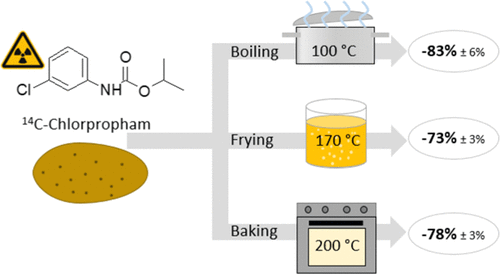当前位置:
X-MOL 学术
›
J. Agric. Food Chem.
›
论文详情
Our official English website, www.x-mol.net, welcomes your
feedback! (Note: you will need to create a separate account there.)
Fate of Chlorpropham during High-Temperature Processing of Potatoes.
Journal of Agricultural and Food Chemistry ( IF 5.7 ) Pub Date : 2020-02-17 , DOI: 10.1021/acs.jafc.9b06386 Bernd Göckener 1, 2 , Matthias Kotthoff 1, 3 , Hans-Willi Kling 2 , Mark Bücking 1, 4
Journal of Agricultural and Food Chemistry ( IF 5.7 ) Pub Date : 2020-02-17 , DOI: 10.1021/acs.jafc.9b06386 Bernd Göckener 1, 2 , Matthias Kotthoff 1, 3 , Hans-Willi Kling 2 , Mark Bücking 1, 4
Affiliation

|
Chlorpropham is a widely used sprouting inhibitor applied on potatoes during their storage. Currently, severe concerns are raised regarding the potential formation of 3-chloroaniline from chlorpropham during heat treatment. The reactions degrading the molecule in the matrix are quite complex under harsh processing conditions, and a molecular investigation is thus challenging. This study aims to decipher the reaction pathways and to discover new metabolites in typical high-temperature food-processing steps. For this purpose, potatoes were treated with 14C-radiolabeled chlorpropham, stored for up to 6 months, and subjected to the traditional preparation steps of boiling, frying, and baking. A quantification method including an acidic hydrolysis was developed for analysis of free and bound analytes. All conducted processing steps led to a substantial mitigation of chlorpropham residues in the consumable products. Of the residues, 17 ± 6% remained in boiled tubers, while 27 ± 3 and 22 ± 3% remained in the fried and baked products, respectively. Chlorpropham was transferred into the surrounding media (boiling water, frying oil, and air, respectively). 3-Chloroaniline was only (raw tubers) or predominantly (processed tubers) present as a bound analyte and was shown to form during storage but not during processing. Additionally, nonextractable and nonquantified residues were detected in the baked and in the long-term-stored tubers after processing. Future studies will have to balance beneficial (mitigating) and potentially hazardous aspects of these results. By transferring the 14C-food-processing approach to a variety of substances, ingredients, and processes, it will be possible to further understand chemical reactions in food processing, finally leading to safer food.
中文翻译:

马铃薯高温加工过程中氯丙胺的命运。
氯丙胺是在马铃薯存储过程中广泛使用的发芽抑制剂。当前,对于在热处理过程中由氯丙胺形成3-氯苯胺的可能性引起了严重关注。在苛刻的加工条件下,降解基质中分子的反应非常复杂,因此进行分子研究具有挑战性。这项研究旨在破译典型的高温食品加工步骤中的反应途径并发现新的代谢产物。为此,将土豆用14 C-放射性标记的氯丙胺处理,最多可保存6个月,并经过传统的煮沸,油炸和烘烤步骤。开发了一种包括酸性水解的定量方法,用于分析游离和结合的分析物。所有进行的加工步骤都大大降低了消费品中氯丙胺的残留量。在残渣中,煮块茎中残留17±6%,而油炸和烘烤产品中分别残留27±3和22±3%。氯丙胺被转移到周围的介质中(分别是沸水,煎炸油和空气)。3-氯苯胺仅(结合的块茎)或主要(加工的块茎)以结合的分析物形式存在,并显示在存储过程中形成,但在处理过程中不形成。此外,加工后在烘烤的和长期保存的块茎中检测到不可提取和不可量化的残留物。未来的研究将必须平衡这些结果的有益(缓解)和潜在危险方面。通过将14C食品加工方法转换为多种物质,成分,
更新日期:2020-02-17
中文翻译:

马铃薯高温加工过程中氯丙胺的命运。
氯丙胺是在马铃薯存储过程中广泛使用的发芽抑制剂。当前,对于在热处理过程中由氯丙胺形成3-氯苯胺的可能性引起了严重关注。在苛刻的加工条件下,降解基质中分子的反应非常复杂,因此进行分子研究具有挑战性。这项研究旨在破译典型的高温食品加工步骤中的反应途径并发现新的代谢产物。为此,将土豆用14 C-放射性标记的氯丙胺处理,最多可保存6个月,并经过传统的煮沸,油炸和烘烤步骤。开发了一种包括酸性水解的定量方法,用于分析游离和结合的分析物。所有进行的加工步骤都大大降低了消费品中氯丙胺的残留量。在残渣中,煮块茎中残留17±6%,而油炸和烘烤产品中分别残留27±3和22±3%。氯丙胺被转移到周围的介质中(分别是沸水,煎炸油和空气)。3-氯苯胺仅(结合的块茎)或主要(加工的块茎)以结合的分析物形式存在,并显示在存储过程中形成,但在处理过程中不形成。此外,加工后在烘烤的和长期保存的块茎中检测到不可提取和不可量化的残留物。未来的研究将必须平衡这些结果的有益(缓解)和潜在危险方面。通过将14C食品加工方法转换为多种物质,成分,











































 京公网安备 11010802027423号
京公网安备 11010802027423号